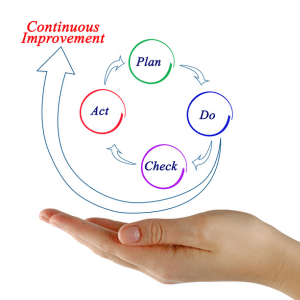Are you tired of creating property content that falls flat? Content Strategy Success is elusive for many. Feeling like you’re pouring your heart and soul into it, only to be met with the digital equivalent of crickets? You’re not alone, my friends.
What if I told you not only how to measure the success of your property content strategy’s success but also give it a turbo-boost?
We’ve all been there—hunched over our keyboards, wondering if anyone out there even cares about what we have to say. You might think, “What’s the point if I can’t even tell if it’s working?” I get it. The struggle is real.
This is a method that’ll have you attracting leads like bees to honey and have your competitors green with envy. Sounds good, right? Well, buckle up because we’re about to dive into the ins and outs of measuring and optimising your property content strategy for maximum impact.
Let’s begin, shall we?
Set clear goals and target the right audience
You know what they say, “A goal without a plan is just a wish.” Well, Antoine de Saint-Exupéry said it anyway 😄. You must have clear and specific goals to succeed in your property content strategy. Without specific goals, you’ll never know if you’re improving over time or heading into the unknown. So let’s get specific! It’s time to stop wishing and start planning.

Using SMART Criteria to Define Goals
You’ve probably heard of this before, but let’s recap anyway, just for fun.
SMART goals were developed by George Doran, Arthur Miller and James Cunningham in their 1981 article “There’s a S.M.A.R.T. way to write management goals and objectives”
Doran, G.T. (1981) There’s a SMART Way to Write Management’s Goals and Objectives. Journal of Management Review, 70, 35-36.
Here is a breakdown of the SMART acronym.
- Specific: Be precise about what you want to achieve.
- Measurable: Set quantifiable targets to track progress.
- Achievable: Ensure your goals are realistic and attainable.
- Relevant: Align your goals with your business objectives.
- Time-bound: Set a deadline to accomplish your goals.
Using this framework, you can ensure your content meets a specific goal and delivers what you intend.
Examples of Specific Goals for Your Property Content Strategy
Now that we’ve got the SMART criteria in mind, let’s get down to business and set a few specific goals for your property content strategy. Here are some examples you can tailor to your own needs.
- Traffic Goal: Increase website traffic by 20% in 6 months
How? By publishing engaging blog posts, creating shareable infographics, and promoting your content on social media platforms.
- Engagement Goal: Boost average blog post session duration by 15% within 4 months
How? By improving the quality and relevance of your content, using attention-grabbing headlines, and optimising your website’s user experience.
- Leads Goal: Generate 10% more leads from content within 3 months
How? By implementing effective lead magnets, creating compelling CTAs, and optimising your landing pages for conversions.
- Conversions Goal: Improve conversion rate by 5% in the next quarter
How? Using persuasive copywriting techniques, optimising your website’s UX/UI, and implementing conversion rate optimisation strategies.

By establishing clear, specific goals using the SMART criteria, you can transform your ambitions into achievable targets. Imagine the outcome when you increase website traffic, boost engagement, generate more leads, and improve your conversion rates!
With a well-defined plan and actionable steps, you’ll be on your way to significantly impact your property business. Remember, success is within reach when you set your sights on measurable, attainable objectives.
This is just one way of using the S.M.A.R.T. method to impact your business. I also talk about using it for creating your content in my book. Yes, there will be a link at the end of this post. 🙂
Identifying Your Ideal Client Persona
You can’t hit a target you can’t see, right? That’s why it’s crucial to identify your ideal client persona. This is a fictional representation of your dream customer, who would benefit most from your property services. By understanding their needs, preferences, and pain points, you can create expert content that speaks directly to them.
Understanding Their Needs and Preferences
You’ve got your ideal client persona in mind; now, it’s time to dig deeper. Dive into the core of their problems and the many questions you know that trouble them and focus on what keeps them up at night. What are their goals and aspirations? What challenges do they face? What type of content resonates with them? By answering these questions, you can create content that genuinely connects with your audience.

Creating Content that Your Target Audience Will Love
Armed with insights into your target audience’s needs and preferences, it’s time to craft content that hits the mark. Focus on addressing their pain points, providing valuable information, and solving their problems. Doing so will build trust and credibility, turning prospects into loyal clients.
Now that you have a solid foundation for setting clear goals and defining your target audience, you can confidently move forward with your property content strategy. Remember, be SMART, be specific, and keep your audience in mind for everything you create. Happy content marketing!
Key Metrics to Measure Your Property Content Strategy Success
You’ve set your goals and pinpointed your target audience – fantastic! But how do you know if your property content strategy is doing the trick? Here are the key metrics that’ll light up the scoreboard and help you measure your content strategy’s success. Ready to become a data-driven property pro? Let’s dive in!

Traffic and User Engagement
Track website traffic and user engagement, such as bounce rate, page depth, and time spent on site, to gauge if your content is grabbing attention. Remember, the goal is to keep ’em hooked and coming back for more! You can’t make a sale if nobody’s browsing, right?
Social Media Metrics
We all want those likes and shares, don’t we? But let’s dig deeper again. Track social media metrics like engagement, reach, and click-through rates to see if your content resonates with your audience.
Leads and Conversions
Leads are the lifeblood of any property professional. Track how many leads you generate from your content. Of course, it’s the conversion rates that really matter to see if you’re hitting the SMART goals we discussed earlier.
Sales and ROI
At the end of the day, what we’re all looking for is a profit. Yeah! It may seem a bit mercenary, but we all know this. Measuring your return on investment (ROI) from your content to ensure you get the biggest bang for your buck might seem obvious, but many miss this crucial step when trying to understand where their revenue is coming from. Even if you’re creating everything yourself, your time still has value, so ensure you include it in your ROI calculations.

Brand Awareness
Building a strong brand is essential. Are people recognising and remembering you? Monitor brand awareness by tracking social media mentions, branded search queries, and direct website traffic.
While your business brand is important, I would recommend focusing on your personal brand since it is you who will build trust and rapport with your leads.
Utilising Content Analytics Tools for Better Insights
So, you’re tracking key metrics and feeling like a content strategy whiz. But let’s be honest – numbers alone can be overwhelming, right? Don’t worry; we’re about to amp up your game with content analytics tools that’ll give you better insights and make your life much easier. Let’s get started! Ready to become a property content strategy expert?
Google Analytics: Traffic and Engagement Metrics

We all know and love Google Analytics, right? Use it to track traffic, user engagement, and conversions so that you can make data-driven decisions. This is the starting point for many tools, so it’s well worth the time to set it up.
HubSpot: Inbound Marketing Performance
HubSpot is the Swiss Army knife of inbound marketing tools. Use it to track leads, conversions, and ROI to help you optimise your content strategy.
Semrush: SEO and Keyword Analysis
Keep your SEO game strong with Semrush. Analyse keywords, backlinks, and organic traffic to outrank your competitors and drive more leads.
Ahrefs: Backlinks and Competitor Analysis
Ever wonder what your competitors are up to? Ahrefs has got your back. Spy on their backlinks, keywords, and traffic to stay one step ahead.
Cyfe: All-in-One Dashboard for Content Metrics
Who doesn’t love a good dashboard? Cyfe helps you monitor all your content metrics making it easy to track trends and make better decisions.
Choosing the Right Metrics and Tracking Your Progress Over Time
Many property professionals in the UK are constantly juggling multiple tools, metrics, and platforms to make sense of their content’s performance. It can feel like you’re trying to crack the code of an ancient mystery, right? You’re not alone.
You might think, “I just want more leads, but how can I measure my content’s success and make a difference?” Well, you’re in the right place. I’m here to show you what key metrics to track and unlock the true potential of your property content strategy.

Tracking Traffic and Engagement with Google Analytics
Getting started with Google Analytics is as simple as signing up for an account and embedding a tracking code on your website. Once you’ve set up Google Analytics, you can explore the dashboard for valuable insights. Look for metrics like total page views, average session duration, and bounce rate. These figures will help you gauge how well your content attracts and retains visitors.
For instance, a high bounce rate might suggest that while you’ve managed to attract your perfect prospect, your content isn’t engaging enough to hold the audience’s attention. You could experiment with different formats, topics, or styles to improve engagement.
Tracking Leads and Conversions with HubSpot
While I cannot give an outline for every CRM out there, I’ll give you an example of integrating HubSpot with your website by installing a Google Analytics tracking code.
Integrating Google Analytics into your CRM is an intelligent move to get the most out of your data. Doing so gives you a powerful combination of data at your fingertips. Here’s a step-by-step guide to achieving this integration and using the data to improve your property content strategy:
- Create a HubSpot and Google Analytics account if you haven’t already.
- Install the tracking code for Google Analytics on your website, following their guidelines.
- In HubSpot, go to the “Integrations” section and search for the “Google Analytics” integration. Click on it and follow the instructions to connect your Google Analytics account with HubSpot.
- Allow time for the data to sync between the two platforms, usually within 24 hours, but it can be much quicker.
- Once connected, access the HubSpot dashboard to view key performance indicators like new leads, conversion rates, and closed deals alongside Google Analytics data on user engagement, traffic sources, and more.
- Regularly monitor the data, looking for trends and correlations between specific content pieces and lead generation or conversions. Monitor metrics like bounce rate, time on page, and conversion rate for different content types.
To obtain statistically significant data, allow for a reasonable timeframe, usually 30 to 60 days, depending on your website’s traffic volume. If you aren’t getting a lot of visitors, this step could take longer. If you get a lot, like thousands a week, then this could be a fairly quick process. Whatever the case, ensuring you have enough data to make informed decisions about your content strategy is the only way to be sure your changes are the right ones.
When you successfully integrate Google Analytics with HubSpot or your own CRM and leverage the combined data to optimise your property content strategy for maximum impact, you’ll start to effectively track your numbers and know what you need to improve.
Monitoring Social Media Performance

Most social media platforms offer built-in analytics tools, providing insights like impressions, engagement, and click-through rates. By tracking these metrics, you can identify which types of content resonate best with your audience and adjust your social media strategy accordingly. Using third-party tools like Sprout Social or Hootsuite to analyse your social media performance will save you a lot of time.
If you find that videos generate more engagement than images or text posts (they usually do), you might consider investing more resources in video production to boost your social media presence.
Measuring Email Marketing Success
Focus on metrics like open rates, click-through rates, and conversions to gauge your email marketing efforts’ effectiveness. Analysing this data will help you identify areas for improvement and optimisation. Many email marketing tools, such as Mailchimp or Constant Contact, provide these insights.
For example, if your open rates are low, you might need to test different subject lines or send times to capture your audience’s attention more effectively.
Using Data to Improve Your Content Strategy
You’ll start to notice patterns and trends as you collect data on your content’s performance. Use these insights to make informed decisions about your content strategy. For example, if a specific content format consistently performs well, consider creating more of that type of content.
Similarly, if specific topics generate more engagement or conversions than others, explore those areas further. Continuously monitor and adjust your strategy based on data to ensure you meet your goals.
Imagine discovering that a specific blog post consistently attracts high-quality leads. This insight could prompt you to create similar content or explore related topics to replicate that success.
Overcoming Challenges in Tracking Content Metrics
Tracking content metrics isn’t without its challenges. Data may be incomplete or inaccurate, and discrepancies may arise between different platforms. To overcome these issues, develop a plan that regularly audits your data, cross-references information from various sources, and addresses inconsistencies.
Remember that while data is invaluable, it’s essential to maintain a balance between relying on analytics and staying true to your brand voice and vision.

Incomplete or Inaccurate Data
Sometimes, you may encounter incomplete or inaccurate data when tracking content metrics. Establish a consistent methodology for collecting and analysing data to address this issue. You can also use multiple tools and data sources to cross-reference and validate your findings. This approach can help you identify and address any discrepancies in your data.
For example, if you notice a sudden drop in your website traffic, check Google Analytics, your content management system, and other analytics tools to confirm whether the decrease is accurate or a result of a technical glitch.
Data Silos and Integrating Multiple Platforms
Data silos can occur when information is stored separately across multiple platforms, making it challenging to get a comprehensive view of your content’s performance. To overcome this challenge, use integration tools and APIs to aggregate data from different sources, providing a holistic picture of your content strategy’s success.
For instance, you can use tools like
to create custom dashboards that consolidate data from various platforms like Google Analytics, HubSpot, and your social media channels. This approach will give you a unified view of your content performance and allow you to make more informed decisions.
Adapting to Platform Changes
Content platforms and analytics tools constantly evolve, affecting how you track metrics. Keep an eye on the updates and changes to your platforms, and be prepared to adapt your tracking methods accordingly. An excellent recent example of this is Google Analytics’ move to GA4. It started as a suggestion, and then it rolled out to the masses. As of July 1st, 23, you can no longer create a GA3 account though some older accounts could still use it. This proactive approach will ensure that you continue to collect and analyse accurate and relevant data.
For example, if a social media platform changes its algorithm or introduces new metrics, educate yourself about these changes and adjust your tracking strategy as needed. By staying agile and adaptable, you can stay ahead of the curve and ensure your content strategy remains data-driven and effective.
Adapting Your Content Strategy Based on Metrics
Content marketing is a long-term game, and staying flexible will help you stay ahead of the curve and maintain relevance in an ever-evolving landscape. Optimising your content strategy requires ongoing monitoring and adaptation. Use the data you collect to make informed decisions about your content mix, adjusting your approach to meet your goals.
Ensuring Consistency Across Platforms and Metrics

When tracking content metrics, it’s crucial to maintain consistency across platforms and data sources. To achieve this, establish a standardised set of metrics to track across all channels. This approach will help you compare and contrast performance, identify trends, and make data-driven decisions to optimise your content strategy.
For example, if you’re tracking engagement metrics such as comments, shares, and likes on your blog and social media channels, ensure that you’re measuring them consistently and applying the same definitions and methodologies.
Benchmarking and Setting Realistic Goals
Setting benchmarks and realistic goals is essential to track your content strategy’s success. Analyse your historical performance data and compare it with industry averages to establish a baseline. Use these benchmarks to set achievable, time-bound targets for your content performance.
For instance, if your average blog post engagement rate is 2%, you might aim to increase it to 3% within the next quarter. Setting realistic goals allows you to avoid frustration and maintain motivation while continuously improving your content strategy.
Regularly Reviewing and Adjusting Your Metrics
As your content strategy evolves, it’s essential to review and adjust the metrics you’re tracking regularly. Some metrics may become less relevant, while others may emerge as more critical to your success. You can focus on the most valuable data and make informed decisions by staying aligned with your goals and performance.
For example, if you find that video content significantly outperforms text content, you might shift your focus to tracking video engagement metrics like views, watch time, and completion rates.
There will often be data that gets ignored because you don’t understand it, or maybe it’s hidden away and don’t know why it’s there. I’d recommend looking at one of these hidden metrics every month or two and finding out all about it.
- Why is it there?
- What does it measure?
- What are the industry standards for it?
- How is it relevant to your audience?
- How can you use it to improve your performance?
You never know when you might come across a correlation that enables you to save time, money, or both while increasing your performance.
Embracing a Continuous Improvement Mindset

A successful content strategy requires a continuous improvement mindset. As you track your key metrics and gain insights into your content’s performance, be prepared to iterate and refine your approach. Stay open to experimentation, learn from your successes and failures, and consistently work toward your goals.
Remember, the landscape of content marketing is constantly changing, and staying adaptable will help you remain competitive and keep your audience engaged. By continuously improving your content strategy based on data-driven insights, you’ll be well on your way to achieving your property marketing goals.
Creating a Content Strategy That Delivers Results
So, you’ve got the know-how and the tools, but how do you turn that into a content strategy that delivers results? It’s like having all the ingredients but no recipe. Fear not – we’ll cook up a winning content strategy that’ll have your property business buzzing with success. Let’s get started! Are you ready to concoct a banquet of captivating content?
Developing Engaging and Relevant Content
As the saying goes, content is king! Craft engaging, relevant, and valuable content that speaks to your ideal client persona. Consider their needs, desires, and pain points, and create content that addresses them effectively.
Distributing and Promoting Content Across Channels
Don’t let your content masterpiece languish on the digital shelf! Distribute and promote your content across social media, email, and offline events to maximise reach and engagement.
Optimising Your Property Blog
Have a property blog? Ensure it’s optimised for SEO, user experience, and conversions. After all, you want to reel in those leads, don’t you?
Tips for Continuous Improvement in Your Property Content Strategy
Embarking on a content strategy journey isn’t a one-time gig – it’s about growth and continuous improvement. But how can you ensure your property content strategy stays fresh, compelling, and in tune with your audience? Are you ready to level up your content-creating system? Let’s go.

Making Data-Driven Adjustments as Needed
Stay agile and adapt your content strategy based on data. If something’s not working, change it up! If it’s working, double down and create more in the same style and about related topics.
This is not rocket science. The more you test, the better you’ll understand what works. Try everything.
Here are some specific steps to leverage data for content improvement:
- Use the data from Google Analytics to identify which content types and topics drive the most traffic and engagement.
- Look at your social media metrics to see which content gets the most likes, shares, and comments. This can help you identify popular topics and formats.
- Use email marketing metrics like open and click-through rates to identify the most effective email content and subject lines.
- Conduct A/B tests on your content headlines, calls-to-action, and images to identify the most effective combinations for driving engagement and conversions.
Adopting a Test-and-Learn Approach
Embrace the test-and-learn mindset. Experiment with new content formats, channels, and tactics, and learn from your successes and failures.
Actually, I want to rephrase that. There is no such thing as failures in marketing. It’s just another lesson on what you won’t do again.
Be Patient and Persistent, and Always be Willing to Learn and Grow
Great content strategies take time to build. As with many things in life, the key is to be patient and persistent and continually refine your approach. You’re unlikely to get everything right on your first attempt. That doesn’t mean you can’t correct, adjust and refine your content over time. This is not a one-shot deal; you can get a piece of content completely wrong and still bring it back later with a better understanding of your audience and their needs and some well-placed edits.

If you take nothing else away from this post, I’d like to understand this; Multi-million dollar advertising agencies still get things wrong. Over the past several years, there have been many instances where companies have been forced to remove ads and apologise because they’ve done something stupid. In most cases, it seems to involve racism, which should be pretty easy to spot. And yet…
What makes them great is that they will analyse a campaign, test and change it, and usually end up with a winner. It has been known for only a single word to be changed in a campaign’s headline to go from zero to hero.
What’s important is you get started and start learning. The rest will come with time, practice, patience, and a better understanding of your audience.
Monitoring and Mastering Social Media Performance
Navigating the lively and ever-evolving world of social media can be overwhelming for anyone. Amidst the noise, how can you make your property content stand out and grab your audience’s attention? Think of it as a treasure hunt, and you’re on a quest to make your content sparkle like gold. Ready to become a social media maestro? Let’s dive in!
Step-by-Step Guide to Enhancing Your Social Media Performance:
Tracking Social Media Engagement and Reach

- Use social media analytics tools (e.g., Facebook Insights, Twitter Analytics) to monitor likes, shares, comments, and impressions.
- Evaluate which content types resonate with your audience and adjust your strategy accordingly.
- Set engagement and reach goals to measure progress over time.
Measuring Click-Through Rates and Conversions
- Use Google Analytics or other tracking tools to monitor your social media post’s click-through rates (CTRs) and conversions.
- Analyse the performance of different post formats (e.g., images, videos, links) to identify which drives the most clicks and conversions.
- Optimise your calls-to-action (CTAs) and landing pages to boost conversion rates.
Identifying the Best Times to Post and Engage
- Analyse your audience’s online activity patterns using social media analytics tools.
- Experiment with posting at different times of day and days of the week to discover when your content generates the most engagement.
- Schedule your posts during peak engagement times to maximise reach and interaction.

Crafting Compelling Social Media Content
- Research trending topics and hashtags relevant to your property niche to create timely and engaging content.
- Mix up your content formats (e.g., blog post links, images, videos, polls) to keep your audience interested and engaged.
- Personalise your content to resonate with your target audience, addressing their needs and pain points.
Analysing Competitors’ Social Media Strategies

- Identify successful property professionals in your niche and analyse their social media presence.
- Take note of their content types, posting frequency, engagement rates, and audience growth.
- Incorporate their successful strategies into your social media plan while adding your unique touch.
Following these steps can enhance your social media performance, ensuring your content shines brightly and captures your audience’s attention. Keep experimenting, measuring, and refining your strategy to stay ahead in the social media game.
Maximising the Impact of Email Marketing in the Property Industry
Email marketing is a classic staple of digital marketing. And guess what? It’s still going strong, even in this social media-driven era. In fact, it’s a hidden gem for property professionals to take advantage of. Are you ready to unlock the potential of email marketing and transform your property business into a lead-generating powerhouse? Let’s dive in!

Growing Your Email List
Think of your email list as a treasure trove of potential leads. To grow your list, offer valuable content, enticing incentives, and captivating lead magnets that drive engagement and conversions. For instance, you could offer exclusive market insights or a free guide on property investments in exchange for signing up for your email list.
Creating Compelling Property Newsletters
Nobody wants to read a dull newsletter. To captivate your audience, craft engaging, valuable, and visually appealing property newsletters that your subscribers can’t wait to open. Feature eye-catching headlines, showcase unique property listings, and share helpful tips on buying, selling, or renting properties. Make it a can’t-miss experience for your audience!
Monitoring Email Campaign Success
Monitor crucial email campaign metrics like open rates, click-through rates, and conversions to ensure your efforts yield results. Use this data to fine-tune your approach, optimise your email content, and craft more targeted messages. By continually monitoring and adapting your strategy, you’ll be well on your way to email marketing success in the property world.

Leveraging Local SEO to Boost Your Property Content Reach
Local SEO – it’s like the hidden gem of the online property world, right? But how do you tap into its potential and get your property content to shine like a beacon in your local market? We’ve got you covered! In this section, we’ll show you how to leverage local SEO to boost your property content reach and become the go-to expert in your area. Ready to put your property business on the local map? Let’s dive in!
The Importance of Local Keywords and Content
Think global, act local! Use local keywords and create content that speaks to your target audience in a specific location to boost your content’s reach and relevance.
Optimising Your Google My Business Listing

Your Google My Business (GMB) listing is crucial to your local SEO strategy. Ensure it’s optimised with accurate information, photos, and reviews to drive more leads. As business citations go, this will be the first of many, but it’s likely to be the most important.
As you might expect, there is a lot more you can do with GMB. Stay tuned since we’ll likely create more content about how to get the most out of Google.
Encouraging and Managing Online Reviews
Reviews can make or break your property business. Encourage happy clients to leave reviews and manage negative feedback gracefully and professionally.

Don’t leave your reviews to chance. When reaching out to every client you’ve successfully concluded business with, you should be asked about your performance, what you could have done better, and any suggestions they might have that would have improved their overall experience. Only then should you ask for a review, which, given everything you know, should be a 4 or 5 star.
With these tips and strategies in hand, you’ll be well on your way to measuring and boosting the success of your property content strategy. Stay patient, persistent, and data-driven, and watch your results soar!
Embrace the Journey and Reap the Rewards
I know it can feel daunting to dive into the world of content creation and measurement, especially when you’re not sure if your efforts will pay off. You might think, “Can I really pull this off and see results?” Trust me, you’ve got this.
Now you have the tools and know-how to create a killer property content strategy, measure its success, and make data-driven decisions to boost your results. It’s not just about the numbers; creating expert content that speaks to your target audience will build genuine connections and trust with potential clients.
Remember, success won’t come overnight. Be patient and persistent, and always keep refining your strategy based on the insights you gain. As you hone your skills, your organic leads will grow, and your business will thrive.

So, what are you waiting for? It’s time to roll up your sleeves and dive into the world of content creation and measurement. Embrace the journey, celebrate your successes, and learn from your challenges. Go on, take that leap of faith – your future self will thank you for it! Before you know it, you’ll stand tall as a property professional making a real impact in the industry.
If you found this article helpful, please do let us know. We’d love to hear your thoughts.
If you’d like to get the complete property leads accelerator system, which covers everything discussed in this post and much more, you can find it all in my book, ‘Automated Property Leads Forever’.











